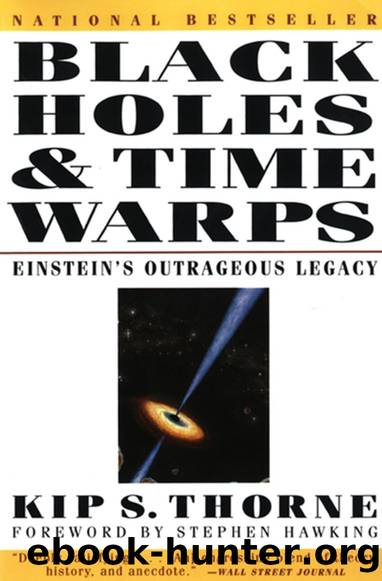Black Holes and Time Warps: Einstein's Outrageous Legacy by Kip S. Thorne

Author:Kip S. Thorne [Thorne, Kip S.]
Language: eng
Format: epub
ISBN: 9780393247473
Barnesnoble:
Publisher: W. W. Norton & Company
Published: 0101-01-01T00:00:00+00:00
9.2 The principle of a radio interferometer. Left: In order to achieve good angular resolution, one would like to have a huge, say, l-kilometer, telescope. However, it would be sufficient if only a few spots (solid) on the radio-wave-reflecting bowl are actually covered with metal and reflect. Right: It is not necessary for the radio waves reflected from those spots to be focused to an antenna and radio receiver at the huge bowlâs center. Rather, each spot can focus its waves to its own antenna and receiver, and the resulting radio signals can then be carried by wire from all the receivers to a central receiving station, where they are combined in the same manner as they would have been at the huge telescopeâs receiver. The result is a network of small radio telescopes with linked and combined outputs, a radio interferometer.
A practical way to make such a spotty bowl was by constructing a network of small radio telescopes connected by wires to a central radio receiving station (right half of Figure 9.2). Each small telescope was like a spot of metal on the big bowl, the wires carrying each small telescopeâs radio signal were like radio beams reflected from the big bowlâs spots, and the central receiving station which combines the signals from the wires was like the big bowlâs antenna and receiver, which combine the beams from the bowlâs spots. Such networks of small telescopes, the centerpieces of the experimental physicistsâ efforts, were called radio interferometers, because the principle behind their operation was interferometry: By âinterferingâ the outputs of the small telescopes with each other in a manner we shall meet in Box 10.3 of Chapter 10, the central receiving station constructs a radio map or picture of the sky.
Through the late 1940s, the 1950s, and into the 1960s, the three teams of experimental physicists (Jodrell Bank, Cambridge, and Australia) competed with each other in building ever larger and more sophisticated radio interferometers, with ever improving resolutions. The first crucial benchmark, the 100-fold improvement necessary to begin to stir an interest among optical astronomers, came in 1949, when John Bolton, Gordon Stanley, and Bruce Slee of the Australian team produced 10-arc-minute-sized error boxes for the positions of a number of radio sources; that is, when they identified 10-arc-minutesized regions on the sky in which the radio sources must lie. (Ten arc minutes is one-third the diameter of the Sun as seen from Earth, and thus much poorer resolution than the human eye can achieve with light, but it is a remarkably good resolution when working with radio waves.) When the error boxes were examined with optical telescopes, some, including Cyg A, showed nothing bright of special note; finer radio resolution would be needed to reveal which of the plethora of optically dim objects in these error boxes might be the true sources of the radio waves. In three of the error boxes, however, there was an unusually bright optical object: one remnant of an ancient supernova, and two distant galaxies.
Download
This site does not store any files on its server. We only index and link to content provided by other sites. Please contact the content providers to delete copyright contents if any and email us, we'll remove relevant links or contents immediately.
The Complete Stick Figure Physics Tutorials by Allen Sarah(7338)
Secrets of Antigravity Propulsion: Tesla, UFOs, and Classified Aerospace Technology by Ph.D. Paul A. Laviolette(5333)
Thing Explainer by Randall Munroe(3909)
The River of Consciousness by Oliver Sacks(3572)
The Order of Time by Carlo Rovelli(3162)
How To by Randall Munroe(3074)
A Brief History of Time by Stephen Hawking(2992)
I Live in the Future & Here's How It Works by Nick Bilton(2960)
What If?: Serious Scientific Answers to Absurd Hypothetical Questions by Randall Munroe(2667)
The Great Unknown by Marcus du Sautoy(2662)
Midnight in Chernobyl by Adam Higginbotham(2516)
Blockchain: Ultimate Step By Step Guide To Understanding Blockchain Technology, Bitcoin Creation, and the future of Money (Novice to Expert) by Keizer Söze(2467)
Networks: An Introduction by Newman Mark(2382)
The Meaning of it All by Richard Feynman(2319)
Easy Electronics by Charles Platt(2308)
The Tao of Physics by Fritjof Capra(2247)
Midnight in Chernobyl: The Untold Story of the World's Greatest Nuclear Disaster by Adam Higginbotham(2196)
When by Daniel H Pink(2098)
Introducing Relativity by Bruce Bassett(2097)
